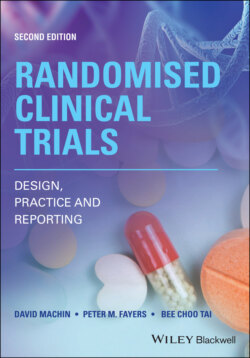Читать книгу Randomised Clinical Trials - David Machin - Страница 13
1.1 Introduction
ОглавлениеThe aim of this book is to introduce those who are to become involved with randomised clinical trials to the wide range of challenges that are faced by those who conduct such trials. Thus, our intended readership is expected to range from healthcare professionals of all disciplines who are concerned with patient care to those more involved with the non‐clinical aspects such as the statistical design, data processing and subsequent analysis of the results. We assume no prior knowledge of clinical trial processes, and we have attempted to explain the more statistical sections in as non‐technical a way as possible. In a first reading of this book, these sections could be omitted. Throughout the book, we stress the collaborative nature of clinical trials activity and would hope that readers would consult their more experienced colleagues on aspects of our coverage.
The business of clinical trials is an ongoing process, and as we write, trials are currently being designed (particularly with respect to the coronavirus), opened, conducted, closed, analysed, reported, results filtered into current practice and the next planned. To describe the key features of this process, it is difficult to know where to start as each stage interacts with each of the others to some extent. For example, in designing a trial the investigators need to be mindful of the eventual analysis to be undertaken as this governs (but it is only one aspect of) how large a trial should be launched. Some of the steps are intellectually challenging, for example, defining the key therapeutic question, whilst others may perhaps appear more mundane, such as defining the data forms or the data entry procedures but all steps (whether large or small: major or minor) underpin the eventual successful outcome – the influence on clinical practice once the trial results are available. For many of these aspects of the process, whole books have been written. We can only provide an introduction to these.
Numerous terms including ‘clinical trial’ itself need to be introduced. As a consequence, we have included a Glossary of Terms, which is mainly extracted from Day (2007) Dictionary of Clinical Trials. Thus, the Glossary defines: clinical trial: any systematic study of the effects of a treatment in human subjects. These definitions may not be exhaustive in the sense, that ‘treatment’ used here may be substituted by, for example, ‘intervention’ depending on the specific context of the clinical trial under consideration.
Clinical trials require a multidisciplinary approach in which all partners play a key role at some stage of the trial process. Furthermore, ‘Evidence‐Based Medicine’ (EBM) requires that it is important to consider critically all the available evidence about whether, for example, a treatment works, before recommending it for clinical practice. In this respect, it is therefore vital that one can clearly see that a proposed trial addresses a key question which will have a clinically meaningful outcome, is well designed, conducted and reported, and the results are persuasive enough to change clinical practice if appropriate.
Despite perhaps not having a professional interest in the science of clinical trials, everyone has a vested interest in them as potential patients requiring care. How many of us have never been to see a doctor, had a hospital admission or taken medication? All of us may be, have been, or certainly will be, recipients of clinical trial results whether during prebirth, at birth or in childhood for vaccination and minor illness, as an adult for fertility, sports injuries, minor and major non‐life‐threatening or life‐threatening illnesses, and in old age for care related to our mental or physical needs.
